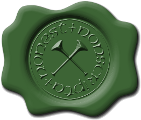Blazon Pattern Search Hints
Here are some hints for using the Blazon Pattern Search Form. The purpose of the form is to find registered blazons that contain particular words or patterns.
Search Types
You can specify a search that is "case-sensitive" or "case-insensitive". A case-sensitive search differentiates upper-case and lower-case letters. For instance, the pattern "or" would match "gore" but not "Or". A case-insensitive search would treat "O" and "o" as being the same, so that "or" would match both "gore" and "Or".
Patterns
The first text entry field is where you type the pattern. The simplest pattern is simply a portion of the blazon you are seeking. For instance, you could type "bat" in this box to find all the blazons containing "bat". This would bring up not only blazons containing the word "bat", but also those containing words such as "batwing", "embattled", "combattant", and "baton".
You can seach for blazons that contain a particular word by sandwiching the word between "\b"s. ("\b" matches any word-boundary.) For instance, you could type the pattern "\bbat\b" to find all blazons containing the word "bat" ignoring words like "combattant" and "bats".
You can specify that you want the pattern to appear at the beginning of a word by placing "\b" in front of the pattern. For instance, you could type the pattern "\bbat" to find all items with batons, bats, and batwings, while ignoring words like "combattant" and "embattled".
You can specify that you want the pattern to appear at the beginning of the blazon by placing a carat (^) in front of the pattern. For instance, you could type the pattern "^Or" to find all registered items with fields Or.
Some punctuation marks have special meaning in patterns. When your pattern includes punctuation marks such as periods (.), question marks (?), or parentheses, it is a good idea to put a backslash (\) in front of each punctuation mark. For instance, to search for names containing "St." you should use the pattern "St\.".
Some common blazon-terms are not consistently spelled. For instance, if you are looking for the word "fleur-de-lys", you might use the pattern "\bfleur-de-l.s\b" to catch both common spellings of the word (fleur-de-lys, fleur-de-lis); the period (.) matches any single character. Alternately, you could use "\bfleur-de-l[iy]s". The portion in square brackets matches a single character which must be one of the two listed (i or y). To specify a wildcard that matches any character except whitespace, use "\S".
If there are multiple letters that you are unsure of, you can use multiple wildcards. If you are unsure of the exact number of wildcards needed, a plus-sign (+) may be used after any wildcard to indicate repetion. For instance, the pattern "\bchevron\b.+\bgules\b" matches any blazon that contains the words "chevron" and "gules" in that order.
You can specify accented characters (such as the ê in vêtu) by typing a backslash (\) followed by the three-digit "Oct" code. For instance, to find "vêtu" you can type the pattern "v\353tu".
Display Options
You can specify how you want your search results sorted. Currently there are three sort options: by name, by date, and by blazon. You might want to sort by date if you know that the item you are looking for is particularly old or recent.
The "Result Limit" option controls the size of your search result. It defaults to 500, but you can change this to another number to see more or fewer results. If more than this number of items match your criteria, you will see a notice linking to an explanation of the limit feature.
The "A.S. Dates" option controls whether dates are shown in modern style (Common Era year/A.D.) or SCA style (Anno Societatis). The SCA calendar counts years from the SCA's "First Tournament" (1 May 1966) and traditionally uses Roman numerals for years.
The "Glossary Links" option controls whether blazons are displayed with links to the heraldic glossary. These links are helpful if you are unclear on the meanings of basic blazon terms.
The "Armory Descriptions" option controls whether armory description codes are shown under each blazon.
Submitting the Search
The button at the bottom of the form marked "search for items matching the blazon pattern" is used to launch the search. No action is taken by the server until you click on the button.
